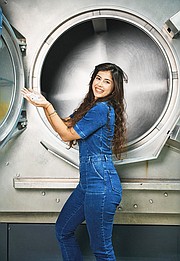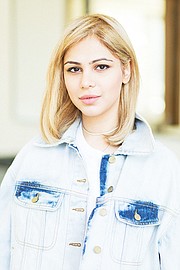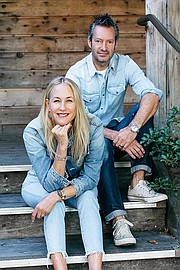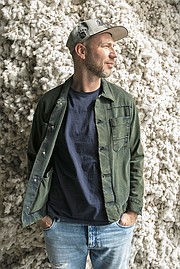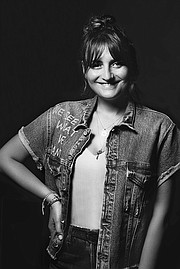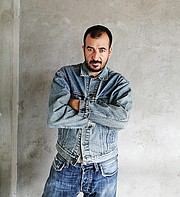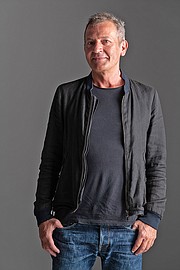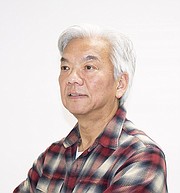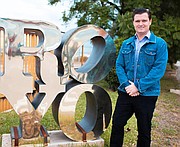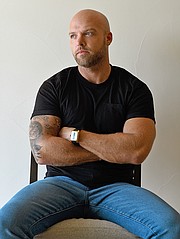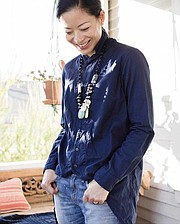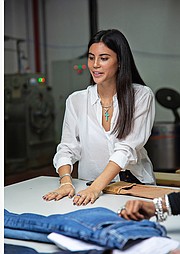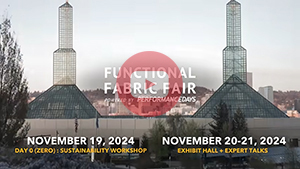INDUSTRY FOCUS: DENIM
Industry Focus: Denim - Denim Experts Weigh In on Design, Responsible Manufacturing, Vintage
Current trends in designing, manufacturing and styling denim relay a sense of going back to the future as demand for vintage pieces soars. Denim experts are not only relying on textile sources from reclaimed pieces to create new designs, in addition to the artistry provided by workers, and washes and finishing that are more responsible, but they are also designing styles that speak to a consumer who values the aesthetics of classic features from previous decades or centuries.
This trend for making what was once old new again has also driven a booming resale market. Vintage connoisseurs and blue-blooded denim veterans on the sales side of the business have dedicated large portions of floor space to sought-after and, in some cases, the rarest pieces that can live on and be loved again. It is in these stores and spaces that denim enthusiasts can talk shop sharing trade insights, while newcomers to collecting can gain an invaluable education regarding this category that has drawn them in.
With design trends favoring fresh approaches to beloved classic designs and the preloved denim business gaining momentum, California Apparel News asked blue-blooded experts: As fashion embraces vintage-jean styles and the resale segment booms, are there any elements of classic denim making that you still love and can align with the modern need for responsible manufacturing?
Beyza Abaykan
Founder and Chief Executive Officer
HM Washing
I like the vintage, worn effect on the garments. The more salt-and-pepper effect there is, the cooler the jeans become.
There are multiple eco-friendly ways of achieving this look, but some affect the strength of the garments, which makes the jeans unsuitable for resale because a weak garment usually breaks and rips after a while.
Hand Made Stone is a sustainable, patented product that achieves these beautiful, bright, vintage looks without affecting the strength of the garments. If a pair of jeans is washed with HMS, you can have the best of both worlds—responsible production and beautiful fades.
Daren Abney
Senior Business Development Manager, Denim
Lenzing’s TENCEL
The best part about a classic denim piece is how worn-in and loved it can feel. While the worn denim tells a story of the wearer, I really just crave the comfort of something familiar and soft. The concept of sustainability is ever evolving, just like the fashion industry. So the intersection of sustainable fashion means less environmental and social impact married with a wardrobe that is in style and makes you feel good.
As the denim industry pioneers new technologies from fiber to finish and continues to make strides in sustainability, vintage denim will continue to play a role—not just in the reduced consumption of new resources but also in the inspiration for adapting an antiquated production method or old fiber in a new, less impactful way. I’m not a collector of vintage denim, per se, but my boot-cut Levi’s from 1999 might be acceptable to be worn in public again. My favorite modern jeans however are Banana Republic’s Traveler Jean for men. It’s the 25 percent TENCEL lyocell blended with cotton and a little poly that makes for a soft and breathable pant for everyday wear.
Sarah Ahmed
Co-founder and Chief Creative Officer
DL1961
DL1961’s family-owned, vertically integrated facilities have been perfecting the vintage jean made with sustainable practices for decades. Utilizing waterless laser and ozone technologies, we are able to achieve the washed-down, authentic look of vintage denim without the harmful chemicals and excess water usage that comes with classic manufacturing techniques.
This year, we also opened our textile-recycling plant in Asia, partnering with Recover to turn post-consumer waste into new fibers. We blend these recycled materials with organic, certified cotton and botanic fibers such as TENCEL to help close the loop on fashion while giving the classic denim fit and feel that will remind you of your favorite vintage pair.
Lemi Arkis
Founder and Partner
Reynas Lable
As the president of a company that produces fashion accessories, Reynas Lable, with a major focus aimed at sustainable and traceable production, my personal responsibility is to target my purchases following the same logic of choice.
When searching for a new garment, the way in which it is produced has always been my first step of choice. A traceable, verifiable and sustainable supply chain has always been, for me, the basis of a new purchase.
True sustainability must also be merged with work ethics, which is an extremely important point and is also the basis of my work internally in my company. Also very important is the choice of materials, avoiding fibers and accessories that are not compostable or recyclable. Knowing that a garment we are buying will enter the waste-disposal problem when its life is over should be another point of choice. This is why I always opt for 100 percent cotton, preferably organic and recyclable, and real leather. As part of the production chain, I try in my own small way to make conscientious buying both for myself and for my whole family.
Wilson Avalos
President
The Common Link, Inc.
Responsible manufacturing is about being mindful of the materials we use, the resources we take and the conditions under which such products are made.
Too much attention has been given to the reuse, recycle or repurpose of materials and how to minimize the use of water and chemicals in the process, among other things. The use of technology has facilitated tremendously the way we do things, keeping us awake and open to new, simple and less harmful ways of processing denim.
While these are very important things to consider, from my perspective nothing is more responsible than improving workers’ conditions and paying decent wages that allow them to improve their quality of life. In a business of people, I choose to focus on what makes the most impact in a world designed to consume more and pay less.
Lela Becker, Co-founder and President
Tim Kaeding, Co-founder and Creative Director
MOTHER
We approach manufacturing in a very old-school manner with a focus on handcrafting and less of a dependency on machinery. Almost every pair of our jeans is made with sandpaper or some other form of artisanal work.
In addition, we’ve always had our production in Los Angeles, allowing us to support the craftsmanship unique to the city as well as fair wages. I have been working with a lot of the same artisans for over 20 years now. We monitor the production process closely so that waste and our carbon footprint are minimal. We have been exploring new technology to reduce water waste, and it has been wonderful to be hands-on in the process.
We have also focused on repurposing excess fabric and samples, which prompted us to launch our first 60 percent MOTHER collection in February 2021, a limited-edition capsule made of pre- and post-consumer waste. Just this week, we launched our third 60 percent MOTHER capsule, and it was the second time we partnered with Carolyn Murphy, the model, actress and environmental advocate. This new limited-edition, surf-inspired collection includes a denim short, The Cheeky Tomcat Short Short, which features repurposed shrink-blanket inserts on the sides for a looser fit around the legs. It has been a very creative and inspirational process to give materials a second life.
Alberto Candiani
President and Owner
Candiani Denim
We are discussing circularity and its gravitational tear. The planet is full of beautiful vintage cloths, denim in particular. Still, the planet is even fuller of crap—unwearable stuff that keeps going burned or landfilled outrageously—polluting the world like nothing else.
So yes, we still need newly manufactured cloths, billions of jeans a year, but we also need to make sure that this new production respects circularity and products are designed and engineered smartly according to their end-of-life solutions so they can all be fully recyclable, biodegradable and compostable.
Kevin Child
Marketing
Edwin USA
As a heritage denim brand, vintage-denim styling and cutting-edge denim manufacturing have always been at the heart of the Edwin USA ethos. As the market for vintage-style jeans grows, we’ve found ways to pair the best parts of classic-denim production with new and innovative technology to meet demand in a sustainable manner while maintaining that coveted look.
Embracing the best parts of traditional denim manufacturing, Edwin USA has begun the process of returning to non-GMO, regenerative cotton fabrics, which are safer for the environment and farmers, as well as minimizing carbon emissions created when shipping by producing locally in Los Angeles, the former capital of global denim production.
Technology and consumer needs do change over time, which is why we’ve also started implementing state-of-the-art production methods to achieve vintage-looking jeans in sustainable ways never before possible. Be it through the use of garment tags made from recycled plastic bottles or laser distressing in place of harmful chemicals to achieve that worn-in look, each step in our manufacturing is carefully considered to keep us on the forefront of denim design without sacrificing style or quality.
Zennure Danisman
Marketing and Washing Manager
ORTA
A denim garment is a masterpiece that only gets better with age. It comes into the world perfect. It is touched and crafted by many hands on its inception to being created.
When you look at a pair of finished jeans in a retail store, you forget how much skill, expertise and energy goes into making a garment. How many sets of hands and complicated processes does one item journey through? From the farmers growing the crops to the dye masters to all the different stations on the sewing floor specialized in making each individual stitch and detail of the garment before it is quality checked and sent out into the world to begin its journey.
Each denim item is like a masterpiece, slowly evolving, never finished. So, at ORTA we are just part of the masterpiece. Part of the creation. Each denim garment gives a voice to the cultures of yesteryears but also holds an unsung promise of tomorrow.
At ORTA we believe, when we buy a garment, we are not actually the owners of that garment. We are custodians. Custodians of perfection! Custodians are looking out for and protecting something. Entrusted to us, for a certain amount of time, we become part of the journey of a garment. ORTA is entrusting a garment to you for safekeeping. Contribute to its timeline and be part of the masterpiece for future generations to enjoy.
ORTA’s promise is fashion-forward, high-quality fabrics that are built to last, crafted with physical and emotional durability, and rooted in eco-modern technologies. We inspire from vintage today’s environmental and human-respective processes and engineer the most authentic looks. We are weaving our stories through our own special denim-history archive by echoing the past, present and future of denim.
Alberto de Conti
Head of Marketing and Fashion Division
Rudolf Group
Most of us agree on the fact that, as individuals, the best thing we can do for the planet is to buy less stuff and use that stuff longer. In the case of clothing, the ideal environmental approach would also require us to wash stuff less. Tricky, but that is when it gets really intriguing if you bring denim into the picture.
Over time, the cultural meaning of jeans has gradually shifted toward a more rebellious character to then become a fashion staple and something that means so many different things to so many different people. However, at its very core, it is workwear that was worn for hard labor. That is often left out of a sort of glamorized view, but it is very much the truth.
Denim has been worn by cowboys, by enslaved African Americans, by those immigrants who basically built America as we know it today. There was a lot of wear and tear back then but not much washing. That wearing process produced some of the most beautiful and precious archive denim pieces we know. In fact, denim bears our own history and is timeless, with abrasions, scrapings and small stains printed on as anecdotes of our existence. A unique second skin. A second skin that can be irreparably destroyed by excessive care, washing and drying.
Home laundering erases everything, but, by washing less, not only do we save huge amounts of water and energy but also extend quality and preserve the romance. In addition to virtuous cotton qualities, traditional spinning and skilled indigo ring dyeing, technologies are available that help extend the wearing time between washes without giving up any emotional comfort. This is the approach that makes possible the coexistence of the original and unique denim lifestyle and modern environmental consciousness.
Eda Dikmen
Marketing and Communications Manager
Soorty
I love recognizing the bond between textiles and culture—there is an immense history, an incredible value looking back at wardrobes.
Denim is the most democratizing fabric—people of all ages, genders, sizes and income levels love jeans. They’re comfortable, versatile and timeless. For sure it went from workwear to statement wear over the years, but it actually did much more. It lived through cultural, industrial and social changes, adapting to them. It now pioneers responsible innovation in fashion, adopting new materials and technologies profoundly. That’s why I think denim has always been, and will always be, a part of our culture.
Until a couple of years back, consumers showing interest in how a pair of jeans is sewn, what goes into the making of denim or how employees are treated was not common, but it most certainly is now. This is where I think the authenticity of the past will meet the demands of tomorrow.
Time will continue shaping our jeans. Biotechnology, being nature inspired and respecting heritage will stay at the core. Vintage jeans were well made, that’s why we’re able to keep going back to them whenever we need inspiration. Their performance and durability were more important than anything—perhaps even aesthetics. I hope that this made-to-last mindset, which made what was once a sturdy textile an essential part of fashion, comes back.
Longevity is a concept we, Soorty, have been working on. Woven with carefully selected materials and vigorous construction processes, we aim to increase product life spans. With fabrics built stronger to last longer, we offer functional and emotional durability as a valid solution to the throwaway culture.
Anatt Finkler
Creative Director
Global Denim
I personally believe that anything done well, with good practices, materials and designed for longevity, can qualify as responsible manufacturing with the ultimate goal of entering a circular supply chain and, therefore, after the user’s life, convert into resale and fit into the category of vintage sale in due time. Classic denim made with 100 percent cotton and made to last was the ultimate way of creating sustainable apparel.
With that being said, manufacturing jeans with natural raw materials such as 100 percent cotton, including recycled pre- and post-, hemp or man-made responsible cellulose materials such as TENCEL and focusing on the detail for proper and long-lasting manufacturing, with use of clean chemicals and dyes, will allow modern manufacturing to keep being responsible, while, of course, never leaving out the social, economic and environmental part of it. We have to understand that jeans will be kept in production no matter how the vintage and resale market booms, yet the key will be that this new production is circular and cyclical where materials can turn back ultimately into new materials to make new products.
Trinidad Garcia III
Founder
Trinidad3
Classic styles have been a staple in fashion storytelling. Vintage jeans tell a story. They are resold and embark on another chapter. I love the fact that we are making future vintage, which will give a snapshot of today’s manufacturing.
Classic denim making with a modern approach is what I’m truly focused on. I’m excited that we can utilize modern techniques to tell the story of today for the generations of tomorrow. The use of E3 sustainable cotton tells the story of the multigenerational American cotton farmers in this modern time. This shows future generations how farming has evolved into a sustainable modern platform. The mills we use have come a long way and continue to innovate techniques toward a cleaner jean. Our factory blends the classic handmade approach with the help of modern sewing machines and making jeans responsibly in the USA. The use of lasers and modern ozone laundry equipment eliminates chemicals and significantly lowers water usage.
Every jean tells a story. I love that our jeans will withstand the test of time and become vintage storytelling pieces one day. They will show how we have embraced the styles of the past with techniques of today that can be here tomorrow.
Lucie Germser
Founder
SPHYNX and The Women in Denim
Why make new garments and try to pretend that the new is old when, meanwhile, we are throwing away and burning tons of existing vintage denim in Ghana and so many other countries?
We shouldn’t focus on the making but rather on better solutions to collect and give old denim second, third and even fourth lives. We should never forget that the most responsible garment is the one that is already in our closet.
Paolo Gnutti
Chief Executive Officer of PG
ISKO Luxury by PG
My work experience originates in a spinning mill specializing in the production of combed yarns for denim. This is one of the reasons why, when I build my new collections, I always start with the design of the yarns by chain and weft, count and slubs.
Another fundamental point is the market analysis—what is there? What is missing that I would like to have and I don’t have? From there, I start to create what the market doesn’t have and that I assume can become a must trend.
What should be a sustainable future for denim? Definitely traceability, knowing exactly for the consumer how that jean was born and what might happen to it when its days end. When I look for a denim to buy and what to check, the first impact is the visual one, and it has to surprise me to stand out among the hundreds of denims that I already own. The second, after the aesthetic of the garment, what hits me is the fit, it has to fit just right. The third is the feel—the fabric, to the touch, must convey what you are looking for even with your eyes closed.
Those like me who have the fortune to have denim in their blood do not need a datasheet to determine whether or not it will be what they are looking for. So, I would say that all you need is to close your eyes, feel it, listen to it and you will surely get what you are looking for—it is not madness, but it is what my everyday experience with denim looks like.
Adriano Goldschmied
Founder
House of Gold
It is true that resale is booming and it is a very good thing. Los Angeles, for decades, is the place to find good vintage denim not only for collectors but also for normal consumers who are trendsetters.
What is new is that this is now a global trend that has a lot of influence in our industry. This is teaching us to work in durability on the product that we design. Basically, we have to focus on making a great product that can last much longer for a second, third life and more. In addition to durability, the jean has to be recyclable and biodegradable. Is not any other place better than L.A. to do this? Our industry is home for premium denim; we have such a deep denim culture, and this is just another good step for more-responsible manufacturing.
Juan Carlos Gordillo
Denim Designer
To apply an element of classic tailoring and align it to the current tailoring is to create a long discussion because some people in the industry and consumers will be in favor and others against, depending on the element we select.
Some of us may think the quality is good. And others will say yes, but the manufacturing was very pollutive because of the processes, the trims and the dyes. However, I am very clear that the only element we should align with is quality, both in selection of materials and in manufacturing.
The quality with which the denim garments that today are vintage were made is very good and makes these garments survive the passage of time.
Now I ask myself, “Is the consumer educated to understand the price of a high-quality product?”
In 2006, it was my first visit to Milan. My sister-in-law gave me denim jeans—Diesel that was made in Italy. Sixteen years later, this pant has survived and has become part of me, and the quality of materials and tailoring are indisputably high.
Another example is a Levi’s jacket that I have had since 2005 when I bought it in only a basic wash. And over time it has taken on wear-and-tear effects. But the quality is incomparable when set against the fast-fashion garments that are produced today.
So, if we rescue the quality of the classic confection and combine it with all the advantages offered by today’s responsible manufacturing, we will be able to create timeless denim garments that in the future will become vintage-collection pieces because of their quality.
Kathy Kweon
President
Saitex USA
As consumers embrace vintage-jean styles and the resale segment booms, Saitex has taken steps to maintain classic elements of denim production while aligning with the need for responsible, sustainable production. For Saitex, the process of denim manufacturing has been carefully considered from seed to shelf starting with the farms where the cotton is grown and ending well after consumers have finished wearing their jeans.
At the newly opened Saitex Mill in Vietnam, we’ve committed to using only organic and transitional cotton to reduce water usage and harmful chemicals associated with other nonorganic cottons—a return to how the first jeans were made. Moving with the fabric from the mill to our production facilities, new technology is paired with traditional methods to maintain sustainability at every step of the process. One such traditional production method utilizes an Ariel drying system to dry jeans post-wash using air and sun—similar to a clothing line you might use at home—allowing us to reduce energy use by 13 million kilowatt-hours and reduce CO2 emissions by 80 percent compared to standard industrial dryers.
Prior to the days of fast fashion, jeans were used, repaired and reused over and over until they were deconstructed for other purposes. Harkening back to this idea of use and reuse, Saitex has even considered what happens to our jeans after consumers are finished with them and have committed to upcycling that fabric waste into new clothing, accessories and even furniture, helping to reduce the waste the apparel industry creates every year.
Through the combination of the best traditional practices and modern technology, we see the future of the denim industry and what it can become, a practice and principle we hope to pass down to future generations who will continue to change the industry for the better.
Susan Lee
Founder
Wilder Los Angeles
On one of my very first days working with the mentor who initiated me into the denim field, he gave me the best advice. He said, denim is simply your canvas. Just like in good art, there are so many layers to the making of jeans. What all denim people have in common is this: We see and we work in layers. This is what I love about classic denim making. The denim is the canvas while the silhouette is the frame to hold the denim, and sewing and washing the denim is like painting a portrait.
What I also learned very quickly is that, in denim, creativity and science are always in tandem. It’s a constant flow between the technical and the artistry. We also work between old and new. I have always had an affinity for vintage both personally and professionally and have consistently used vintage for inspiration when creating a seasonal collection. But now, vintage has taken a bigger stake in the creative process. As the vintage resale segment booms in our industry, I not only use vintage as inspiration but also now use vintage physically to create newness. As a whole, fashion and design have become multi-dimensional and taken new pathways recently to incorporate vintage. A few examples are upcycling vintage pieces into new ideas and recycling fibers to create new fabrics from old ones.
We really have to acknowledge the importance of pop culture and applaud the younger generation for embracing this. They are the ones who are really driving this new way of creating forward. Because of their demand for a more sustainable world, we are all able to make denim more responsibly and even more creatively than before. Conserving rather than wasting is the forefront of our consciousness when we create jeans now.
Daniele Lovato
General Manager
Elleti Group
Traditional jeans making is deeply rooted in Elleti Group’s vision. Our goal has always been to preserve the know-how and craftsmanship that made Italian denim a leader in this industry segment while enriching and integrating our original “old- school” signature treatments and handworks with the latest technological innovations.
The artisan’s touch, combined with the tools available today in terms of sustainable chemistry and advanced machinery, allows us to bring to the market a fresh and green vintage product that perfectly mimics the authenticity of long-worn garments or any other declination of the denim concept. On the other hand, classic denim making and jeans treatments are not only about look but more importantly about creating a durable, functional garment that fits your lifestyle, enduring all kinds of stress while aging without breaking. Therefore, we work to create a treatment that does not affect the natural durability of denim, washing the garments with less and less aggressive processes to the benefit of both the consumer and the environment. With our most environmentally friendly process, Wiser Wash, the entire laundry cycle is shortened compared to traditional washing, guaranteeing a tear resistance of the final product that will make it last longer, just as denim did in its early days.
While the Wiser Wash technology reduces the consumption of water, energy and chemicals and completely eliminates the use of pumice stone, it has become clear that to be able to offer the most sustainable garments on the market the focus should also be on sourcing a selected range of materials that support and enhance the treatment itself. Sustainability, in fact, concerns every step of the supply chain, and the fashion industry can no longer afford to think only of the end result and neglect the bigger picture.
Otello Lucietto
Group innovation Director and Country Manager—Italy
Riri Group
Within Riri Group, which now includes zippers, buttons, metal components and fashion jewels, Cobrax stands out, creating different types of iconic buttons and rivets. As a reference point for the luxury and denim markets, Cobrax underlines innovation, quality, beauty and originality.
Riri and Cobrax, denim pioneers since the ’70s, interpret the meaning of denim as a lifestyle, which crosses and mixes not only past and present but is also able to influence young and future generations.
Today, one of the most crucial aspects is represented by environmental protection and by reducing in a drastic way both pollution and resources waste.
Thanks to new generations, a much more sensitive approach is given to the protection of the planet, and the denim sector is demonstrating the ability to maintain the classic aesthetic and communicative canons and standards while prioritizing today’s environmental and social emergencies.
Riri is continuously improving its path toward sustainability, paying attention to how to use different resources in the production processes. We are committed to further progressing our environmental efforts and goals, starting from the publication of our second sustainability report in accordance with the Global Reporting Initiative, which includes economics, environmental, social and governance indicators and measurements.
Jeans and denim represent a specific fashionable movement that never dies but will continue to evolve and be present. Now, like yesterday, indigo-colored vintage denim is the most opted for.
Today, softer and more elastic materials have taken over. Examples include cottons mixed with elastic fibers or mixed with other natural materials such as linen, hemp or cashmere. In addition to that, we can affirm that the resale segment is an excellent example of responsible consumption and also a smart opportunity to champion circularity.
Elegance, functionality and style coexist together with sustainable materials and treatments with Riri and Cobrax.
Gabriella Meyer
Owner and Designer
Denimcratic
Repurposed denim is having a moment in the “see-and-be-seen” summer of 2022. Inventive and novel garments are creating the show-stopping looks currently favored by the industry and consumers alike. But has denim ever not been “in the moment”? The fabric’s decades-long versatility is a testament to the material’s natural and hard-work aesthetic that resonates with the wearer.
At Denimcratic, we focus on small-batch production and 1/1 designs. This allows us to blend classic-jean design with current style trends while also reducing overproduction and waste. We love to reuse and restyle old 100 percent cotton jeans as the hardware, materials and stitching can be superior and the natural wear is always unique. Our custom consumers, buying the 1/1s, like to participate in the design process, and we enjoy this type of partnership. Our hope is that these garments have an extended life span since the customer is so invested in the process—just another way to reduce our footprint and be responsible.
The current denim-resale boom reflects the consumer’s interest in well-designed jeans, but, more importantly, denim buyers have learned that fit comes first! A perfect pair of jeans that feels just right takes on such meaning. The vintage or reuse trend supports this appreciation for form and fit. Personally, I am always honored to own and pay homage to a designer by reusing a beautifully made vintage garment. As a business owner and creator, I learn so much from those who have paved the way in this industry.
Ethically speaking, denim manufacturers have really stepped up with innovative fibers and thoughtful processing. As an industry, it has been a commendable effort by many to focus on environmental impact, and I am proud to be part of this community and buy my fabric and hardware from these vendors.
Alaina Miller
Vice President of Full Package Operations
Star Fades International
While I do love “fashion” denim and playing with new details and silhouettes, I could never trade in five-pocket blue jeans with traditional details. These days, recreating a timeless aesthetic while manufacturing responsibly can be done in a variety of ways. Choosing fabrics with recycled content that are 100 percent degradable is one way to manufacture denim more consciously. Additionally, advances in technology have made it possible to create beautiful vintage-looking washes that require less water and completely eliminate pumice stone and harmful chemicals, resulting in less harm to the planet.
Brad Alden Mowry
Owner and Founder
Artisan Cloth
Denim making is an art as much as a science. I think those of us with a little of the creative and the technical in our souls really appreciate and enjoy this fashion craft. It started with the love of how indigo wears in. Natural whisker marks, worn knees and hems, and other natural abrasions from constant wearing of a jean is the idea of what most brands try to emulate industrially now—as if your “new” jeans had been worn for years right out of the package.
From the initial styling and fit there is creative engineering happening, including fabric selection, thread colors, stitch details, pattern and fit details, wash and aesthetic details, determining the shrinkage and impact the chosen industrial wash process has on the final product’s fit, durability and quality.
The wash itself is an absolute merge of the creative and technical. If there is laser, graphic-design skills are involved to create an authentic-looking worn pattern—hand sanding and other methods of highlighting and lightening very specific chose areas. All of this to emulate a vintage or naturally worn jean.
So many things are now considered to keep this aesthetic but reduce the carbon footprint. From the cotton origins to fibers being recycled, or from a renewable resource to specific indigo products that reduce water use or toxic-chemical use. it’s an ongoing, ever-evolving pursuit of excellence with responsibility. What a joy to get to work in such a creative and technical field.
Massimo Munari
Art Director
ISKO Creative Room
Vintage and secondhand are indeed the new trend, especially as Gen Z has realized that reducing fashion’s environmental impact could coincide with reuse and giving new life to garments from the past.
Today, there are lots of successful apps that encourage selling and exchanging secondhand garments, making an increasing number of consumers interested in this sector and fashion more and more circular. We must, however, acknowledge that although it is a growing phenomenon the world of secondhand globally remains a very small slice of the market and that in many secondhand stores you can also find garments that “look” vintage but have been created recently.
Therefore, there is much talk about “new vintage” as an emerging trend in the denim market. I believe that wearing vintage is not only a trend but so much more. It represents two eras that meet, a past that comes back to life today. It is a combination of garments with a story to tell—that still today influence our way of living and dressing. As a vintage lover, given my experience of over 30 years in the fashion world, I find that the elements or particular constructions of classic, vintage denim do not represent a sustainable approach as we define it today, but they can surely align with today’s need for responsible production.
Thanks to research, innovation and the development by market leaders of new fabrics made from increasingly sustainable fibers, a commitment to a responsible supply chain and the use of new technologies, we are able to produce vintage-inspired garments while reducing the use of virgin materials and substances that are harmful to the environment and people. And last but not least, without compromising the need for comfort and style.
Ebru Ozaydin
Strategic Marketing Director—Denim, Wovens, Ready-To-Wear
The LYCRA Company
It is absolutely a pair of red selvage denim! Jeans faded with personal marks of repeated wear, a blue-blood wardrobe investment—a preloved, ever-loved item, whether heavy, dark worn-in or beaten-up fade. It is currently not so easy to find unless you’re lucky to catch one at a flea market or at the Rose Bowl Pasadena or you’re lucky enough to travel to Japan. But there are mills that still have traditional shuttle looms and beautifully merge the authentic look of selvage denim adding enough stretch for improved comfort.
My dream of such reinterpretation would be using recycled cotton and LYCRA EcoMade fiber blended with hemp or COOLMAX EcoMade technology made from 100 percent textile waste for a climate-adaptive version, not forgetting made from responsibly dyed fabric and a waterless wash. Hallelujah!
Özge Özsoy
Marketing Chief
Bossa
Inspired from denim origins, we created a “Heritage” concept. Keeping our roots in the ground of denim history, we created real heritage looks with innovations in technologies and content. They are in the old flavors that we miss, and the performance of the fabrics is superior.
Denim has undergone a reinvention back to denim roots. Heritage is inspired by old-school denims—traditional authentic fabric constructions with authentic yarn shapes, vintage indigo shades, coarser counts.
An “old-look new denim” is born. This is the look you like with all the advanced performances so far and together with the will to go toward a more sustainable way to produce and create wonderful denims.
With our Heritage concept we have 100 percent sustainable FUTURE DENIM items. From the roots of denim combining sustainable fibers and dyeing techniques we create the denim of the future. This collection features fabrics with sustainable fibers and yarns such as organic cotton, recycled cotton, recycled polyester, ECO T400 LENZING lyocell with REFIBRA technology and post-consumer recycled denim. These fabrics are dyed with Bossa’s Saveblue technology, Zero Water and Zero Waste.
Ron and Jill Perilman
Founders
Liverpool Los Angeles
We would say all or most of the denim mills we use in depth at Liverpool Los Angeles have already embraced the need for sustainable fabrics. Recycled and organic cotton, vegetable dye processes, recycled poly and many new concepts are the norm. It is now our responsibility as a brand to enforce using recycled marketing and packaging, low-impact garment washing and factory monitoring—all are the necessary next steps to complete the manufacturing cycle.
Liverpool has mandated all garment washing be low impact; for instance, the use of less water, recycled water, ozone and laser machines are now fully enforced. That being said, the vintage trend has been a part of our collection for several years now and is lately gaining even more momentum with consumers enjoying and choosing to wear crop flares, bell-bottoms and wide-leg flares.
Regarding consumers choosing old vintage clothing over newly manufactured vintage looks, it’s important to realize most truly vintage denim is rigid, and rigid non-stretch denim is in vogue in our collection currently for selected styles; however, based on our sales data most of today’s consumers are opting for vintage-denim fabrics and vintage-denim washes with new stretch properties to which they have grown accustomed.
Dominic Poon
Chief Executive Officer
Twin Dragon Marketing
Twin Dragon Marketing is bringing classic and vintage-denim elements back through mid- to heavy-weighted items, marble aesthetics, defined twill lines and substantial grin-through that are durable yet soft. Our Americana collection combines sustainable modern technology with an old-school nostalgia to create a truly modern, sophisticated denim. We incorporate recycled fibers, TENCEL lyocell, liquid indigo and an eco finish, offering the most eco-friendly denim available that also has the benefit of being biodegradable. All items in the collection are versatile to fit any style like low-rise boot, straight and loose silhouettes.
Our dedicated determination to preserve and protect precious natural resources for future generations has led and continues to lead our devotion for responsible manufacturing. We are creating and utilizing the newest technologies to reduce water usage, hazardous chemicals and CO2 emissions. As a result, we have eliminated freshwater usage at our Mexico mill by working with the local government to offer residential areas clean water for their use first. The government gathers that used water and filters it to send to our mill for manufacturing, rendering the water utilized at the production level 100 percent recycled.
We are bringing back classics remixed with sustainable and modern techniques to create the cleanest denim that is trendy and fashionable.
Jose Royo
Vice President
Tejidos Royo
We, as denim-fabric producers, believe that the mix of the new with the old is the key to success. Today, the words are “recycle,” “circular economy,” “second life,” “vintage” and “authentic.” With the new recycled fabrics, we are trying to have the same effect of the classic-denim look and hand feel.
What should we do different? Instead of using metal rivets, let’s use color stitching; instead of using metal zippers, we can use recycled plastic zippers. The eco design is as important as the raw materials used. If the garment design is developed from a recycled point of view, we will have an eternal denim looking as it was produced in the 1930s.
Today, we are manufacturing fabrics with all components recyclable, making the most sustainable fabric for the classic jean with a new twist—the eternal classic denim.
Miguel Sanchez
Director of the Board
Transformers Foundation
As we all know, modern denim was originally created as a working article meant to be strong and last long even if a heavy stitch of rips and applying patches to holes were required. It evolved to be a symbol of an attitude toward life by the late ’60s and early ’70s to become a fashion icon in the ’80s.
Over those years, the meant-to-last denim helped to develop concepts like vintage or reused. I can recall well when passing my jeans to my younger brothers, maybe after some repair work was normal. Glad to see that this concept of extending the life of good jeans is back.
Non-denims, such as garment dyeing and processing, and short-life denims, just to meet fast-fashion demand, will never be vintage. There is no spirit. Vintage means that the article transmits an emotional value and that this value can increase as the garment goes from user to user. Some styles have become legends.
There is still a small industry producing denim fabrics and garments in an artisanal way. Fortunately, the demand for these, inspired by traditional articles, is increasing and the materials, application processes, styles can be well aligned with responsible manufacturing in a stepwise manner that considers:
• Design—old five-pockets in all its forms—slim, straight, boot-cut, tapered—and engineered to last;
• 100 percent cotton is the material of classic denim and still offers many options for future styles;
• HQ ring-spun warp;
• Shuttle-loom woven selvage;
• Not-too-flat fabric constructions with some irregularities to give character;
• Vast fibers or selected cotton for threads;
• Buttons—there is a wide selection of nice alloys and finishes that are also valid for trims; and
• Spirit and passion.
Pierette Scavuzzo
Director Product Design
Cone Denim
Classic denim constructions are timeless, and Cone Denim has the great privilege of having generations of knowledge, know-how and archives to reference and inspire today’s fabrics. This is an exciting moment for the denim industry, fueled by the consumer’s affinity for vintage styling and advocacy for sustainable advancements and responsible manufacturing. The dramatic shift in silhouette, updated post-pandemic wardrobe needs, and a revived interest in vintage and resale for denim circularity is really helping to re-engage the consumer in a 150-year-old product.
What’s exciting is that we can reconstruct vintage styles using alternative fiber blends such as recycled and regenerative cotton, hemp and TENCEL along with natural and recycled dyes that are produced with manufacturing processes that save water, chemicals and discharge zero-process wastewater into the environment. Five or ten years ago, you could not have imagined making denim in a facility like Cone Denim Parras, which is reducing its overall water usage by 100 million gallons annually compared to previous years’ consumption.
Denim mills and brands are uniquely unified in putting our world first. The beauty in what we can do today as denim-fabric makers is to design the fabric in a way that performs best with the most-sustainable garment-finishing techniques. This is very important to close the loop for denim from fiber to finish, providing an authentic, responsibly produced garment.
Mike Simko
Global Marketing Director, Textiles
Hyosung
I’d say my favorite part about classic denim making is that when I was young and bought a pair of jeans they were stiff and board-y yet over time they faded and softened with each wash. It was almost like they evolved to my body for the perfect fit.
The exciting part about responsible denim making is that we no longer have to wait for our jeans to soften and fit comfortably. We can be confident that the denim finishing we do today is better for the environment than the fading we did long ago through home laundering, which released dyes into municipal-waste streams.
We should all be proud of new eco-friendly fibers and finishing that have helped denim mills and brands with their individual sustainable solutions.
For instance, Hyosung’s creora 3D Max spandex helps brands and mills achieve their circularity objectives with the Ellen MacArthur Foundation’s Jeans Redesign guidelines for recyclable denim. Among its guidelines is a requirement that denim be made with a minimum of 98 percent cellulosic material, leaving 2 percent of the content for stretch or synthetic material.
To achieve the recovery needed, the typical solution has been a mix of polyester and spandex, creating a dual core that can more effectively bounce back; however, this added polyester content means that synthetic yarns make up 8 to 12 percent of a finished garment, preventing denim from meeting the 98 percent threshold for Jeans Redesign requirements for circularity. Creora 3D Max spandex delivers a high-performance stretch denim with the required recovery and replaces the synthetic dual core with a 2 percent spandex content allowing stretch denim to be recycled.
For denim brands looking to make jeans with renewable resources, Hyosung’s bio-based creora bio-based spandex replaces 30 percent of petroleum-based raw materials with those derived from dent corn.
Amanda Starling
The Business of Denim Chair
Executive Director, Industry Relations and Career Center
Special Projects Chair
International Manufacturing and Product Development Chair
Fashion Institute of Design & Merchandising
The challenge is in the question itself. Shopping vintage was once a hot spot for industry professionals—a source of vital importance for designers looking for trend, inspiration and wash references. It has now become a fashion norm for consumers and industry alike.
Vintage sales are on the rise, especially in classic silhouettes. Customers want to feel the history and stories of their garments, and the old adage rings true: “They just don’t make things like they used to.” Contemporary vintage shoppers want different things—from the thrill of the hunt to a highly curated luxury experience, the appeal of vintage is the humanization of well-loved garments.
Modern jean manufacturing is adhering to the design standards of the past, adopting classic silhouettes and added durability while innovating by foregoing trims for more-sustainable options and utilizing cutting-edge fabric technology; in this way, the future is found in the past.
Brands are being pushed to come to their consumers with creative, earth-friendly solutions for branding, wash alternatives and lower waste production while maintaining the authenticity of classic denim. Customers vote with their dollars, and the direction of the market is clear—sustainability is top-of-mind whether acquiring old or buying new. Responsibly manufactured denim offers the longevity necessary for the beloved characteristics of heritage denim to emerge.
Adam Taubenfligel
Co-founder and Creative Director
Triarchy
The only thing about classic denim making that I still love and can align with is a responsibly made pair of jeans that looks like a vintage pair of jeans. Thankfully this aesthetic can be achieved with materials made with low water consumption in mind, without harmful chemicals being applied during the wash processes and without harming workers’ health. Anyone still applying the vintage techniques to achieve these vintage aesthetics is doing so in a way that I don’t align with.
The word sustainability in fashion has lost its integrity because the only really sustainable brand would be one that doesn’t exist. If we’re making new products from virgin and/or blended materials then we should stop using the “S” word. It really doesn’t make any sense.
However, if we take a step back in the alphabet, we land on the letter R, which for me and my team stands for responsibility, a word that still does have integrity. Responsibility is a word I can get behind because it offers a framework to operate a brand when trying to make jeans better and therefore better jeans. We all know what responsible means. We know when we are making responsible versus irresponsible decisions in life and in business, so there are no excuses if you choose to operate under responsibility versus the S word.
The innovations we all have access to today as denim designers make this work exciting again—exciting because we never know what the next innovation will be, but it will be our efforts in operating responsibly that bring these innovations to the forefront and exciting because we know we are doing our best to make denim responsibly so we can leave the planet’s resources intact for future generations to continue making denim responsibly.
Alice Tonello
Marketing, Research and Development
Tonello
I think that the approach of buying more responsibly, even choosing used or reconditioned garments, is a growing trend with great appeal, but it will not be able to block new creations and the classic denim market; on the contrary, it can influence it in a positive way with recurring and interesting inputs and elements.
Fashion often takes cues from the past, reinterpreting styles in new ways, with a technological level—both in fabrics and treatment—that is certainly more cutting-edge.
Today, a vintage garment can be created with reduced water and energy consumption, with recycled fabrics and new natural fibers. This is the beauty of research, technology and the present. A new way of working, without forgetting the past but reinterpreting it in a new way.
Jason Trotzuk
President and Creative Director
Fidelity Design House Ltd.
The history of denim is unique in the fashion industry as denim is inherently a non-fashion item, but because of its longevity and social importance it has become a fashion staple.
In the early years denim was workwear for the blue-collar class who had factory jobs and needed a strong, dependable pair of pants or dungarees to wear to work.
It was only several years after when the denim wearers in the factory came out and into the coffee shops and pool halls of America. Wearing denim outside of the factory was considered rebellious and made denim an outlaw in the eyes of the public. It was with this sense of rebellion that denim became the consumer choice for the rebellious generations throughout the last 50 years who chose blue jeans to be the common man’s uniform. Think Woodstock, punk rock, ’70s disco, ’90s grunge, country western.
With this notion, countless hours are spent by designers and makers alike trying to recapture looks and feels from the past where people can reconnect with a moment or an event that brings them back to that cool moment in their lives.
Denim has also become comfort, versatility and accessibility, and when we want to identify with or be recognized or go traveling or doing almost anything, denim is the voice for it. Denim is accepted in casual settings, business and semi-formal circles, with an immediate acceptability of coolness and confidence.
Denim is everything. It is the single most important item of clothing, and I can appreciate people’s enthusiasm for recycled vintage. It inspires me and gives me hope in consumers’ awareness and acceptability of responsible manufacturing. I feel this moment inspires designers to do better and be better at making blue jeans and sustainable items that are in line with consumer demand.
Adam Vanunu
Co-founder and Chief Executive Officer
Cotton Citizen
At Cotton Citizen, our family-owned and -operated dye house is constantly focused on innovation and the evolution of decades-old techniques that have been utilized throughout history. Responsible manufacturing for the modern era is key to our success and is equally as important to our team and our customer.
While our dye house specializes in traditional garment-dye and denim treatments, we are shifting our focus to utilizing new techniques involving sophisticated laser technology to replicate the beloved heritage and worn-in treatments made popular over the years. In addition, new ozone technology provides natural bleaching capabilities and limits the need for stonewashing while reducing water consumption and chemical use throughout the manufacturing process. Our facilities are being converted to utilize recycled water to limit our environmental impact, allowing us to replicate and update classic denim-making techniques to be more sustainable and efficient for the modern era.
Andrea Venier
Managing Director
Officina39
Consumers are increasingly aware of the impact of their choices and their impact on the planet, but when they choose denim they expect it to be iconic and authentic. Because we know this, as players in one of the most critical industries in the world, we also have a responsibility and an obligation to do all we can to bring about positive change and act for good, safeguarding the product specificity, quality and tradition.
That is the reason we are thoroughly evolving and improving our Trustainable technologies to replace more-conventional ones and preserve the authenticity of the final look with the least possible impact. Thanks to the unique combination of traditional craftmanship and cutting-edge innovations, we are able to provide astounding, sustainable results.
Our innovative Aqualess Mission concept, featuring four advanced laundry products for one innovative process, allows for water-consumption savings up to 75 percent. To get vintage looks and create the well-loved worn appearance, our Aqualess Mission involves Novascraper Indigo, a laser-finishing technique that adds a natural, classic look to denim garments; OZ-ONE Powder, an advanced product to give garments a bleached yet eco-friendly treatment for a worn and distressed look; Aqualess Aged, a waterless compound to give denim-abrasion effects; and Aqualess Fade, a technology that recreates the bleaching effect of chlorine on fabrics.
To make classic denim we need to redesign it with authentic fade patterns and tints. Through our Recycrom technology we can create a full range of pigment powders using textile fibers derived from used clothing and manufacturing waste. The new Ozone Booster SMART O3, our latest technological innovation, provides more-definitive bluish indigo shades than other boosters on the market by activating the ozone reaction on indigo without any strong oxidizing agent. Better results, less aggressive bleaching: 100 percent classic.
Vivian Wang
Managing Director and Global Sales Manager
Kingpins Show
When I first started in denim, Adriano Goldschmied taught me that everything in denim design should have a purpose or a function. There’s a reason for the rivets or why the pockets are stitched that way.
Before the pandemic, I visited brands in China and met with a company that had just begun working in denim. The designer asked me how to keep the color from fading. I explained that that is the beauty of indigo—that is why it’s so unique.
The new generation of denim designers and consumers move so fast. Everything for them is online and everything is visual. I wonder how well they know the history of denim, why jeans are designed the way they are and how the way indigo fades is part of the authenticity of jeans.
As they start learning about denim and exploring the history, I hope they use the past as a reference to create something totally new rather than just recreating the past. You see that with all the innovations in sustainable processes that reduce the amount of water or chemicals or are less harmful to workers than traditional methods. There was a time when the only way you could get that pale-blue shade of denim was with a lot of water and a lot of bleach. Or if you wanted to create a classic stonewash you had to accept pumice sludge as a by-product of the process. That’s not true anymore.
These days, you are able to recreate authentic-looking vintage details, like light-wash denim or a classic stonewash, much more responsibly. That shows an appreciation for vintage authenticity without sacrificing a commitment to sustainable practices.
To me, the best of all worlds is one that brings traditional, authentic washes into the future using modern—and more-responsible—manufacturing methods.
Ani Wells
Founder and Director
Simply Suzette
Denim suppliers have been proactive in finding innovative solutions to achieving vintage looks with fewer resources, and the industry has been very open and receptive to new ideas for responsible manufacturing. But, as we look to future-facing technology to save us, many look to the history of making jeans for inspiration.
The elements I love and think modern manufacturing can align with all come down to designing for durability and functionality. For example, as we look to avoid the use of rivets for ease of disassembly, denim brands’ solutions to Levi’s patented rivet birthed many creative ideas for reinforcement, such as using different bar tacks like circles and Xs.
I am also a big fan of ring spun–yarn qualities for their superior strength to open end and the unique and varied wear pattern they create.
Lastly, the quality of vintage denim is something I would love to align with. The speed at which we are producing and the different product-quality tiers are obviously not conducive to this; however, vintage is the way it is today because of the time and skill that went into it. If we want to increase the times a pair of jeans is worn, taking a quality-first approach, like the vintage denim we see today, is non-negotiable.
Michelle Zhu
Chief Executive Officer
Huue
A core tenet of modern manufacturing is using better and more-advanced materials without product compromise. Biology has allowed us the opportunity to create sustainable, bio-based color without trade-offs to our wardrobe or the planet. Huue’s indigo dye is based on advancements in bioengineering that observe how plants produce colors in nature and replicates the process in a way that is scalable and financially viable while maintaining the purity and consistency of synthetic colors.
Huue’s business model is to work hand in hand with consumer brands and their supply-chain partners to integrate its biomaterial as a drop-in replacement in their operations and develop co-branded lines of products—starting with jeans—powered by Huue technology. Huue’s bioengineered indigo has five times less toxicity potential compared to chemical sources and eliminates fossil-fuel reliance and dangerous, carbon-intensive processing that impacts the population health and environments of garment-producing communities.
Moreover, the solution is bio-identical to petrochemical dye and is just as effective and easy for denim makers to implement without pain of adoption or change in their manufacturing pipeline. This unlocks the power of biology for durable, vibrant color that doesn’t compromise on quality while making our manufacturing process more eco-friendly.
RELATED STORIES
- Embracing Responsibility While Building a Profitable Business
- Industry Focus: Denim—What advancements and innovations within denim make you hopeful for the future of the industry, and how will these contributions create progress in the category?
- Denim With Less Water Demonstrated, Discussed at Calik Event at ECO PRK
- Midnight Studios Launches Sustainably Made Denim Collection

